高中英语《Unit 4 Wildlife protection》Reading课文语法填空 新人教版必修21
- 格式:doc
- 大小:37.01 KB
- 文档页数:2
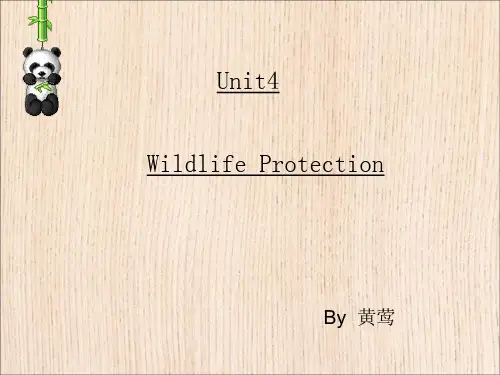
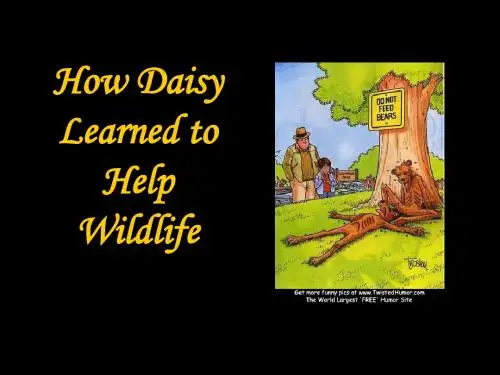
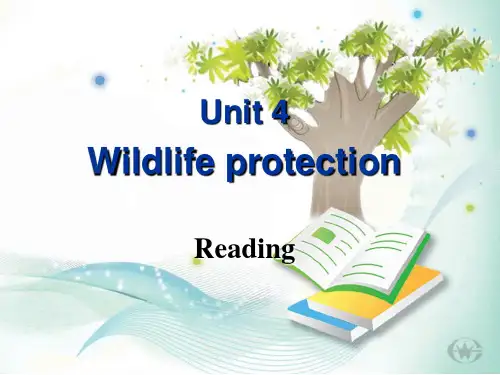
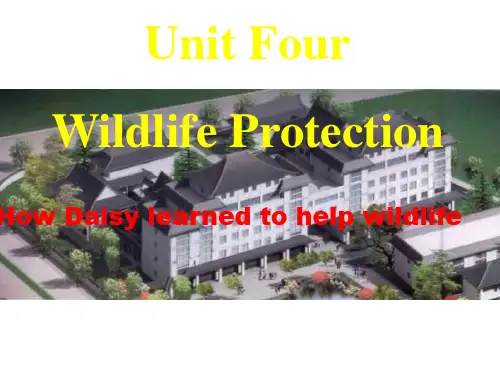
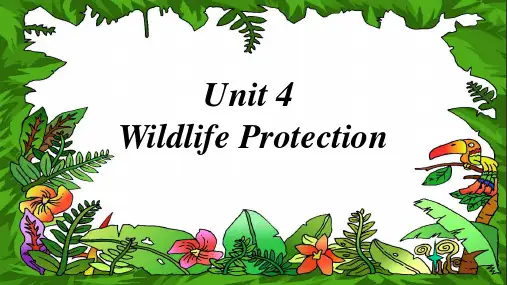
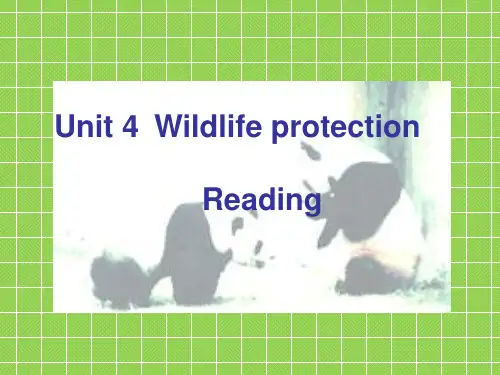
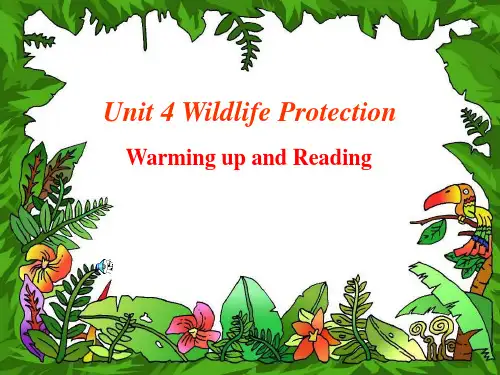
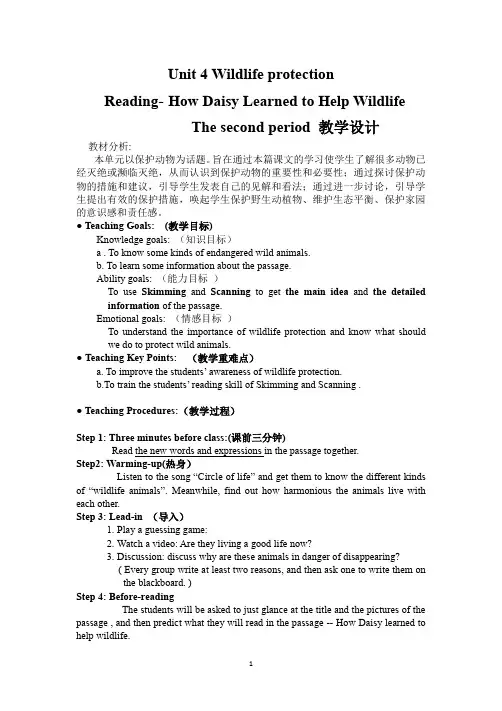
Unit 4 Wildlife protectionReading-How Daisy Learned to Help WildlifeThe second period 教学设计教材分析:本单元以保护动物为话题。
旨在通过本篇课文的学习使学生了解很多动物已经灭绝或濒临灭绝,从而认识到保护动物的重要性和必要性;通过探讨保护动物的措施和建议,引导学生发表自己的见解和看法;通过进一步讨论,引导学生提出有效的保护措施,唤起学生保护野生动植物、维护生态平衡、保护家园的意识感和责任感。
● Teaching Goals: (教学目标)Knowledge goals: (知识目标)a . To know some kinds of endangered wild animals.b. To learn some information about the passage.Ability goals: (能力目标)To use Skimming and Scanning to get the main idea and the detailed information of the passage.Emotional goals: (情感目标)To understand the importance of wildlife protection and know what should we do to protect wild animals.● Teaching Key Points: (教学重难点)a. To improve the students’ awareness of wildlife protection.b.To train the students’ reading skill of Skimming and Scanning .● Teaching Procedures:(教学过程)Step 1: Three minutes before class:(课前三分钟)Read the new words and expressions in the passage together.Step2: Warming-up(热身)Listen to the song “Circle of life” and get them to know the different kinds of “wildlife animals”. Meanwhile, find out how harmonious the animals live with each other.Step 3: Lead-in (导入)1.Play a guessing game:2.Watch a video: Are they living a good life now?3.Discussion: discuss why are these animals in danger of disappearing?( Every group write at least two reasons, and then ask one to write them onthe blackboard. )Step 4: Before-readingThe students will be asked to just glance at the title and the pictures of the passage , and then predict what they will read in the passage -- How Daisy learned to help wildlife.Step 5: While-reading (阅读)1.Listen to the tape once:2. Fast reading(略读)(1). Read the passage quickly and try to answer the questions:a.Is it a true story? Why?b.How many animals are mentioned in the story?c.How many places has Daisy been to?(2). The main idea of the passage ______.A. Some protection of wildlifeB. A journey of a flying carpetC.With the help of the flying carpet, Daisy had a wonderful experiencewith some animals (Suggested answer: C)3. Read the passage again, and match the main idea of each paragraph.Paragraph Main idea1 a good example of wildlife protection2 why we need wildlife protection3&4 what we can get from wildlife protectionStep 6: Conclusion1.Read the dialogue in roles:2.Discussion: After learning the passage, what should we do to protect wildanimals?The possible advice:1.We should treat the wild animals the same as our friends.2.We shouldn’t cut or kill them freely.3.We shouldn’t eat wild animals’ meat.4.We shouldn’t buy the clothes that made of animal’s fur.5.We shouldn’t pollute and destroy the wild animals’ habitats.6.We should protect the environment around us to let them have enough foodand good living conditions.Step 7: HomeworkPlease read the passage three times and underline the key words and difficult sentences.后旗一中姚逸君。
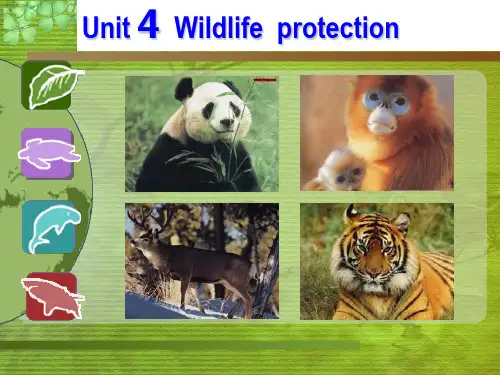
![Unit 4 WIldlife protection-Reading[阅读课件]](https://uimg.taocdn.com/b3dc8205c5da50e2524d7fa3.webp)
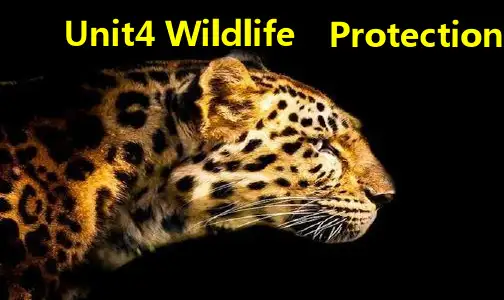
Unit 4 Wildlife protectionPart One: Teaching DesignPeriod 1: A sample lesson plan for reading(HOW DAISY LEARNED TO HELP WILDLIFE)AimsTo talk about endangered speciesTo read about wildlife protectionProceduresI. Warming up by learning about animalsLook at the photos below and listen to me telling you about the animals, the endangered animals.The Giant Panda is a mammal now usually classified in the bear family, Ursidae,that is native to central China.The Giant Panda lives in mountainous regions, like Sichuan and Tibet. TheGiant Panda is the symbol of the World Wildlife Fund (WWF), a conservationorganization. Toward the latter half of the 20th century, the panda also became somewhat of a national emblem for China, and is now used in Chinese gold coins.Giant Pandas are an endangered species, threatened by continued loss of habitat and by a very low birthrate, both in the wild and in captivity. About 1,600 are believed to survive in the wild.Milu deer is a Chinese deer. It has a long tail, wide hooves, and branched antlers. Another Chinese name for it is “four unlikes,.〞because the animals were seen as having the horns of a stag, the neckof a camel, the foot of a cow, and the tail of an ass.These animals were first made known to Western science in the 19th century, by FatherArmand David, a French missionary working in China. At the time, the only surviving herd was in a preserve belonging to the Chinese emperor. The last herd of Milu deers that remained in China were eaten by Western and Japanese troops that were present at the time of the Boxer Rebellion.These deer are now found in zoos around the world, and a herd of Milu deer was reintroduced to DafengReserve, China in the late 1980s. They are classified as “critically endangered.〞in the wild, but do not appear to have suffered from a genetic bottleneck because of small population size.A tiger is a large cat famous for its beautiful fur of orange striped with black.Tigers live in Asia and are being very rare. This is due to people hunting themfor their fur and destroying the forests they live in.II. Pre-reading1.Defining wildlifeWhat does the world wildlife mean?The term wildlife refers to living organisms that are not in any way artificial or domesticated and which exist in natural habitats. Wildlife can refer to flora (plants) but more monly refers to fauna (animals). Needless to say, wildlife is a very general term for life in various ecosystems. Deserts, rainforests, plains, and other areas—including the most built-up urban sites—all have distinct forms of wildlife.Humankind has historically tended to separate civilization from wildlife in a number of ways; besides the obvious difference in vocabulary, there are differing expectations in the legal, social, and moral sense. This has been reason for debate throughout recorded history. Religions have often declared certain animals to be sacred, and in modern times concern for the environment has provoked activists to protest the exploitation of wildlife for human benefit or entertainment.2.Reading to the recordingNow turn to page 26, listening and reading to the recording of the text. Try to keep pace with the native reader, making your reading resemble that of the reader, in speed, in intonation and in pronunciation.3.Reading and transformingNow you are to read the text for information to fill in the form.What did Daisy see where she was?In Tibet in China Zimbabwe In thick rain forest4.Reading and underliningNext you are to read the text and underline all the collocations at the same time.III. Closing up by matching animals to five risk categoriesDifferent endangered species appear on different endangered species lists. And people who are trying to protecting animal use the following five risk categories to group the unlucky animal.Now in groups of four try to group all the unlucky animals found in China.。
《Unit 4 Wildlife protection》Reading
How Daisy Learned To Help Wildlife
一、语法填空(根据课文内容完成短文)
One day a girl called Daisy dreamed a strange dream. She 1________ (fly) to Tibet in a flying carpet and talked with an antelope. The sad antelope told her that they 2________ (hunt) because their fur can be used to make sweaters for people 3________ her. In several years they may all be gone. Later, Daisy was taken to Zimbabwe 4________ she talked with an elephant and learned 5________ (happy) that the farmers there n o longer hunted them. That’s 6_________ the government decided to help and asked the tour companies to bring 7________ (tour) to the area to take photos or to hunt. And they set 8________ number of animals to be hunted. As a result, farmers made a lot of money. At last, Daisy arrived at a thick rainforest where a monkey told her that it had found a millipede insect and rubbed it over ________ 9________ body to prevent mosquitoes. The monkey also told her, “No rainforest, no animals, no drugs.” 10________ it was only a dream, Daisy had learned so much.
参考答案:
一、
1. flew
2. were hunted
3. like
4. where
5. happily
6. because
7. tourists
8. the
9. its
10. Though/Although。